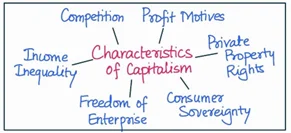UPSC CSE : 2014
Answer:
| Approach:
Introduction
Body
Conclusion
|
Introduction:
Capitalism is an economic system in which most or all of the trade, industry, and means of production are owned by private people and used to make money. Capitalism is based on private property, the accumulation of capital, a competitive market, and wages.

Body:
Capitalism thinks that markets are the only way to get goods to people quickly and efficiently, and that the market’s “invisible hand” regulates things to get the most good for the most people. While laissez-faire economy has delivered high economic gains, they have not been equitable and has promoted a highly unequal society.
Capitalism has problems like social inequality, unfair distribution of wealth and power, a tendency toward market monopoly or oligopoly, imperialism, counter-revolutionary wars, different types of economic and cultural exploitation, materialism, repression of workers, social alienation, and economic instability. This leads to high Gini coefficient in the society and its attendant problem like social unrest, wide spread distress, lower human development indicators etc.
Moreover, unregulated markets as being self-correcting has been laid as lie by 2008 financial crisis which was perpetuated by lightly regulated banking sector in western countries. This light regulation led to taking up excessive risk for higher pay by bankers and in end lead to collapse of the system which spread to main street economy causing widespread distress due to freezing of credit.
Even in the West, it was important to have rules about labour and the environment to protect these vulnerable areas. Under the capitalist model, it is not possible to bring growth to the most people in India in a way that is inclusive. It’s important to have a mixed mode of economy, which means adopting socialist values while giving everyone in the market a fair chance.
Conclusion:
Capitalism needs to be regulated for delivery of greatest economic growth to greatest number of people for achieving inclusive growth. The idea of balancing both sides is what makes sustainable growth and inclusive development possible.
<div class="new-fform">
</div>